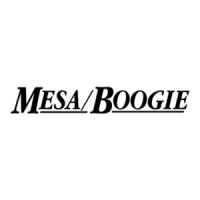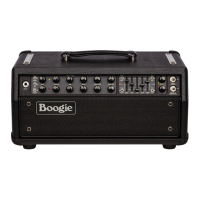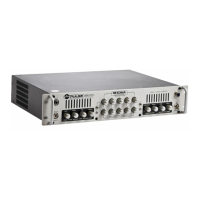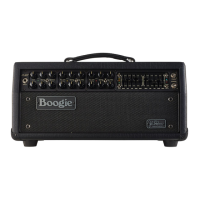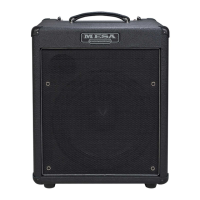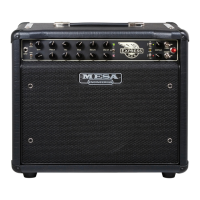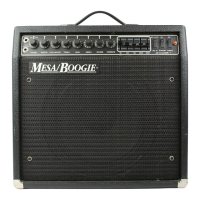PAGE 24
The most common application where the 6600 slider is boosted is seen in heavy rock and metal sounds for
the fabled “V” setting. Here the 750 Hz Slider is dipped below the center line for a midrange scoop, 2200
kHz is boosted to near or above the upper line for the attack Heavy Crunch sounds need, and the 6600 kHz
somewhere around the upper line adds the harmonic edge and haze. The two lowest sliders are most often
boosted to near the upper line for these sounds as well to add the “chug” on the low end. In total, this “V-Curve”
all adds up to a huge sound that has been a staple on classic and modern rock and metal albums since the late
‘70s when the Boogie 5-Band Graphic EQ first appeared on our MARK I Boogies.
Dipping or cutting the 6600 kHz slider is most often associated with searching for warm, round single-note
solo sounds, be they clean for jazz-style sounds or higher gain for rock and fusion music. Dropping the 6600
slider below the center line removes the harmonic content from the sound, and this happens rather quickly.
Some players dip both the 6600 and 2200 for ultimate warmth, while others boost 2200 a bit as the 6600 is
being reduced, to retain definitive attack or swap its frequency as the sound gets darker. Either way you go,
the 6600 slider comes in handy when you want to customize your sounds – especially those infused with gain
– and, for a bright guitar with weaker, vintage-style pickups you love for clean work but perhaps struggle with
trying to get a warm jazzy or overdriven solo sound from.
Now that you have an overview of the Graphic EQ and a better understanding of the frequency points and
how they might be used to attain or enhance the sounds you want, we suggest spending some time exploring.
Getting to know how the 5 Bands interact with the rotary Tone controls in the Channels and what is most ef-
fective where will help you navigate the many sounds available in the MARK VII more quickly and accurately.
Regardless of how you choose to apply it, the Boogie 5-Band Graphic EQ helps set the MARK Series amplifiers
further apart from others in creating an ultimate palette for your expression.
REVERB
The MARK VII features an analog all-tube spring reverb circuit that produces a lush ambient reverb eect and
oers independent mix controls for each of the 3 preamp Channels. Independent controls for each Channel’s
Reverb means you can embellish your preamp Mode choices with just the right amount of the reverb eect for
whatever musical style you have dedicated a Channel to. From subtle background reverb to a drenched wash,
the reverb enhances the sounds you dial up, adding dimension and a more spatial landscape.
The Reverb is activated via the two-position mini toggle located in the lower right-hand corner of the Graphic
EQ (cutout) window. To hear the reverb mix setting you have dialed up on the stacked REV mix knobs in the
EQ cutout window, the REV mini toggle must be set to the ON (switch up) position.
NOTE: It is normal to hear a “swelling in” of the Reverb when switching between Channels. This is due to a timed “Reverb
Mute” circuit necessary so that, for example, your overdriven big Crunch Rhythm chord or burning high note at the end
of a solo doesn’t wash over your beautiful clean arpeggiated chording as you switch back to Channel 1 or 2 (or even 3 in
IIB Mode set low) for a featured part where the band stops in a “breakdown” section. We’ve chosen a length of time that
reduces the sound passing through the Reverb circuit (Reverb Tank included) by about 75% so that the residual Reverb tail
from the part previously played in another Channel will not overshadow what is currently being played.
This time will likely be judged in terms of both chronological measurements (like seconds) and musical application (as in
Bars/Measures), and this will be overlayed on tempo ranges (BPM/Beats Per Minute). Being a purely analog piece of gear,
we do not have an internal clock to apply to these complex variables, so in true musical fashion, we used our ears and our
50+ years of experience in what has made musicians happy to arrive at a balance of feature meets function.
MESA FOOTSWITCH! You may also control the Reverb (on/o) via the MARK VII Footswitch, where there is a footswitch
button provided for this function. When using the MESA Footswitch to switch your Reverb, the REV select mini toggle in the
EQ cutout window must be set to the lower OFF/FS position to operate.
NOTE: If you connect the Footswitch when powered up, or you power down and back up with the Footswitch connected and the
Reverb doesn’t come on, simply toggle the Front Panel REV switch ON and back OFF to reset the circuit and engage the switching.
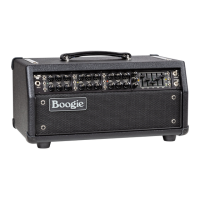
